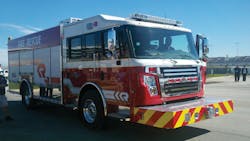It’s not often one gets to drive a fire apparatus on a NASCAR-based test track, but some 300 invited guests got to do that when Rosenbauer unveiled its Commander cab and chassis at Texas Motor Speedway in Fort Worth. Four prototypes were made available for testing by fire service professionals who were asked to critique the apparatus. Company officials promised to take back the constructive ideas and integrate them into the design.
The event marked a first for the company and the first new fire service vocation truck manufacturer to enter the market in a long time. There are many truck builders, but only a few that build on their own platforms from the ground up. Rosenbauer joined their ranks this year with the unveiling of this new product in February.
One of the first things noticeable about the apparatus is it is quiet from the outside and the inside. Rosenbauer made sure the noise level was kept down. Rosenbauer uses Cummins ISC, ISL and ISX 12 platforms with horsepower ratings from 260 to 500. The engines are mated to the appropriate Allison transmission, either the 3000EVS model or the 4000EVS unit, based on horsepower. The quiet continues inside as communications between all occupants in the apparatus, front and back, can be carried on at conversation levels without any need to shout, even coursing around the test track at 40 mph. In addition, the truck takes corners well and braking was more than adequate. (The prototype was driven for 100,000 miles on a test track for durability verification.)
Before building the new cab and chassis, Rosenbauer asked customers to describe the most important things firefighters and mechanics need to do their jobs well. The company said it started with a blank piece of paper and designed everything without the constraints of fitting it into what was already being made or the need to maintain a status quo.
Some of the innovations are simple, like angling the corners of the engine dog house to provide a little more hip room for the operator and the officer. Rosenbauer said that was done to accommodate extra items carried in bunker coat pockets, but it also provides comfort for larger firefighters.
The designers located controls within easy access on a wrap-around dash with intuitive locations for the most-needed knobs and buttons. With multiplexing standard for the Commander’s electrical system, on screen controls are available. Rosenbauer also worked out the heating, ventilation and air conditioning (HVAC) system. Vents are placed strategically throughout the cab to maximize climate control. No huge ductwork and AC components intrude into the cab area impeding forward vision and headroom.
Even a little thing like angling the rear self-contained breathing apparatus (SCBA) seats inward slightly makes for more shoulder room and a little more comfort for those in the back. Seating can be configured for up to 10 occupants with 60- and 70-inch extended cabs available. Roofs can be flat or rose by 11 or 24 inches.
Rosenbauer makes it cabs from 3/16th-inch aluminum plate with a heavy-duty aluminum extrusion frame. It also has stamped aluminum corners and front fascia, an industry first. Front-end designs to accommodate round or square headlights are available at the customer’s preference. Coming around the sides, the doors are wider than industry standards and steps are lower to make egress easy, even for firefighters with full turnout gear and airpacks. Because the doors are wide, they don’t need to open to a full 90-degree angle, which prevents the doors from being over extended and damaging the edges or the cab body.
Built with safety in mind, Rosenbauer crash tested cabs for front-impact and side-impact airbag deployment. It can also withstand a 120,000 pound roof crush test.
“We wanted to make sure we tested everything before we went to market with it,” said Harold Boer, president of Rosenbauer America, based in Lyons, SD.
Those gathered for the unveiling included mechanics who noted the access to the vehicle’s running gear the Commander provides. The tilt cabs rise to almost 90 degrees, providing easy access to the engine and transmission. Mechanics remarked that they couldn’t find anything that was not easily accessible. Even the battery box folds down and makes a step for access to internal components.
Accessibility was also a consideration for Rosenbauer in parts selection. Many items used for maintenance are off-the-shelf components, which reduces downtime and expense – no need to go back to Rosenbauer for proprietary maintenance parts. The company says well stocked, locally operated parts store should have most needed items.
Meeting the latest federal emissions tests was not a problem for Rosenbauer. The company took into consideration every aspect of the new technology and integrate it into the original design. There was no need to retrofit anything into existing designs.
“We passed all the emissions testing the first time with no problems,” Boer said. That’s an achievement, considering some engine manufacturers have dropped the fire service because of difficulties meeting the emissions standard within the constraints of a fire apparatus.
Rosenbauer America is building the cabs and chassis in a new facility in Wyoming, MN, adjacent to its General Safety Equipment plant. The company said a new division, called Rosenbauer Motors, will handle the business side of building cabs and chassis.
Kevin Kirvida is president of Rosenbauer’s Minnesota division. He said it made sense to build the cabs and chassis there because the company has gained experience building ground-up apparatus with its aircraft rescue and firefighting (ARFF) equipment experience. Rosenbauer’s Panther is built in Minnesota, so the company has materials, products and experience building ground-up apparatus.
Completed cabs and chassis can stay in Minnesota to become finished apparatus, or they can be shipped to South Dakota for finishing, depending on customer location and preference. The Commander is a custom cab and chassis made exclusively for Rosenbauer and can be used for aerials, pumpers, rescues and tankers.
With four apparatus already built, more in production and some already ordered, Rosenbauer was expecting to have the first Commander units delivered and in service by the end of April.
“We’re really pleased with the way this came out,” Boer said. “We think it’s the safest, most innovative cab and chassis available today.”
ED BALLAM, a staff writer for Firehouse.com, is a captain with the Haverhill Corner, NH, Fire Department, a nationally certified EMT, and holds certifications in emergency vehicle operations and pump operations. He is also a deputy forest fire warden for the New Hampshire Division of Forests and Lands.
?








